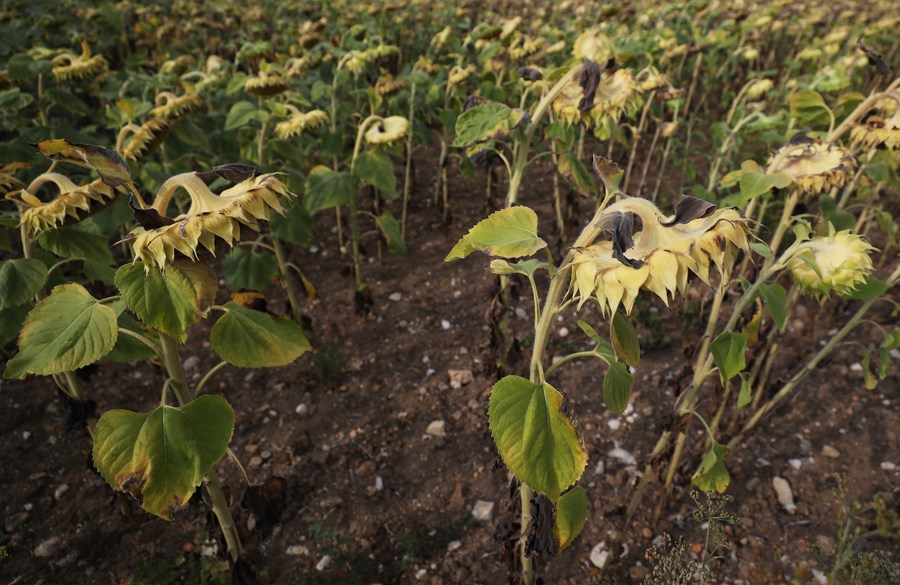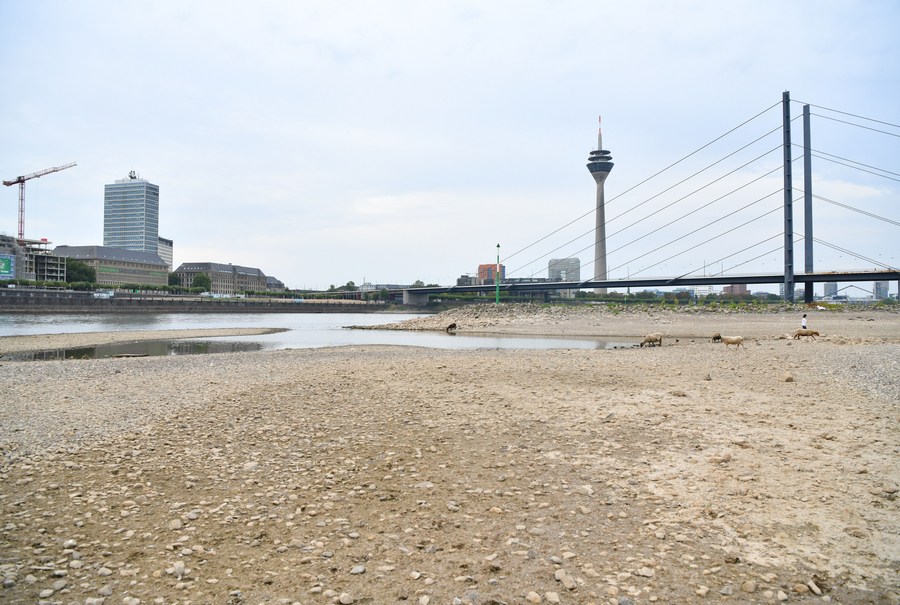The EDO pages contain drought-relevant information such as maps of indicators derived from different data sources (e.g., precipitation measurements, satellite measurements, modelled soil moisture content).
Different tools, like Compare Layers, allow for displaying and analysing the information and drought reports give an overview of the situation in case of imminent droughts.
You can download most drought data used in the European and Global Drought Observatories following this link.-->
According to the latest map of the Combined Drought Indicator | |
|
Europe facing worst drought in 500 years: EU agency
Source: Xinhua
Editor: huaxia

A dried sunflower field is seen as a severe drought hits France, in Puiseux-Pontoise, about 30 km northwest of Paris, France, Aug. 18, 2022. (Xinhua/Gao Jing)
"The severe drought affecting many regions of Europe since the beginning of the year has been further expanding and worsening as of early August," said a report by the European Drought Observatory, adding that the western Europe-Mediterranean region is likely to experience warmer and drier than usual conditions until November.
BRUSSELS, Aug. 23 (Xinhua) -- Europe is experiencing its worst drought in at least 500 years, with almost two-thirds of the continent in a state of alert or warning, a European Union (EU) agency said here on Tuesday.
In its August analytical report, the European Drought Observatory (EDO) said that some 47 percent of Europe is under warning conditions due to a severe lack of soil moisture.
Another 17 percent of countries are in alert conditions.
"The severe drought affecting many regions of Europe since the beginning of the year has been further expanding and worsening as of early August," the report said, adding that the western Europe-Mediterranean region is likely to experience warmer and drier than usual conditions until November.
The drought has disrupted inland shipping and electricity production, and reduced the yields of certain crops, it said.
The current drought appears to be the worst in at least 500 years, assuming final data at the end of the season confirm the preliminary assessment, the European Commission said in a statement.

A dried corn field is seen as a severe drought hits France, in Puiseux-Pontoise, about 30 km northwest of Paris, France, Aug. 18, 2022. (Xinhua/Gao Jing)
Summer crops have suffered, with 2022 yields of grain maize set to be 16 percent below the average of the previous five years and soybean and sunflowers yields are set to decrease by 15 percent and 12 percent, respectively.
Hydropower generation has also suffered a hit, with further impact on other power producers due to a shortage of water to feed cooling systems.
Low water levels have hampered inland shipping along the river Rhine and elsewhere, with reduced shipping loads affecting coal and oil transport.

Photo taken on Aug. 17, 2022 shows the bank of River Rhine in Dusseldorf, Germany. (Xinhua/Ren Pengfei)
Mariya Gabriel, European commissioner for innovation, research, culture, education and youth, said: "The combination of a severe drought and heat waves has created unprecedented stress on water levels in the entire EU. We are currently noticing a wildfires season sensibly above the average and an important impact on crops production. Climate change is undoubtedly more noticeable every year." ■
Europe is facing its worst drought in at least 500 years, with two-thirds of the continent in a state of alert or warning, reducing inland shipping, electricity production and the yields of certain crops, a European Union agency has said.
The August report of the European Drought Observatory (EDO), overseen by the European Commission, said that 47 percent of Europe is undergoing warning conditions, as moisture in the soil dries out and 17 percent of the region is on a state of alert as vegetation is affected.
“The severe drought affecting many regions of Europe since the beginning of the year has been further expanding and worsening as of early August,” the report said, adding that the western Europe-Mediterranean region was likely to experience warmer and drier than normal conditions until November.
Much of Europe has faced weeks of baking temperatures this summer, which worsened the drought, caused wildfires, set off health warnings, and prompted calls for more action to tackle climate change.
The current drought appeared to be the worst in at least 500 years, assuming final data at the end of the season confirmed the preliminary assessment, the Commission said in a statement on Tuesday.
Summer crops have suffered, with 2022 yields for grain maize set to be 16 percent below the average of the previous five years and soybean and sunflowers yields set to fall by 15 percent and 12 percent respectively.
Hydropower generation has been hit and other power producers affected due to water shortages that feed cooling systems.
Low water levels have hampered inland shipping, such as along the Rhine river, with reduced shipping loads affecting coal and oil transport.
The EDO said mid-August rainfall may have alleviated conditions but in some cases, it had come with thunderstorms that caused further damage.
The observatory’s drought indicator is derived from measurements of precipitation, soil moisture and the fraction of solar radiation absorbed by plants for photosynthesis.
Europe facing its worst drought for 500 years: Study
47 percent of Europe is under warning conditions with clear deficit of soil moisture, European Drought Observatory says.




No comments:
Post a Comment